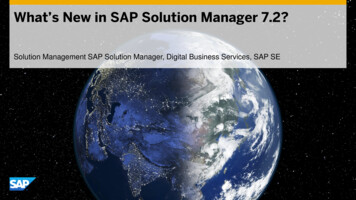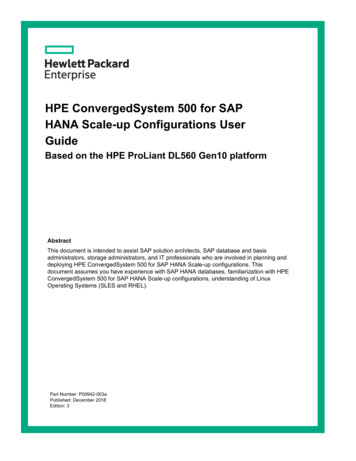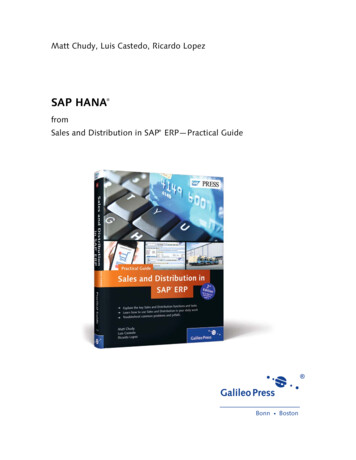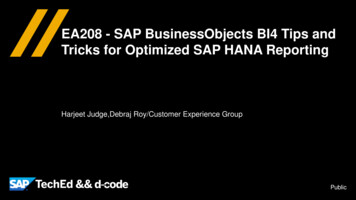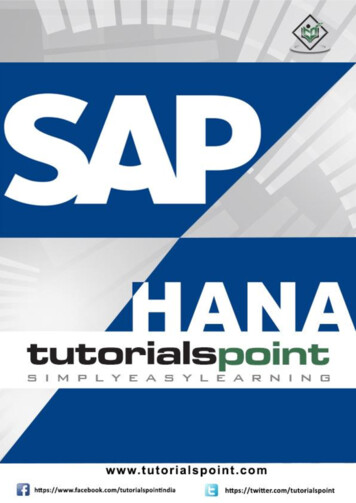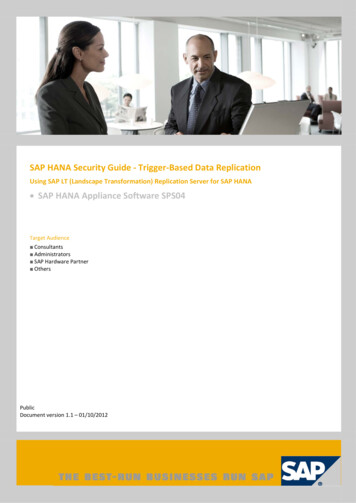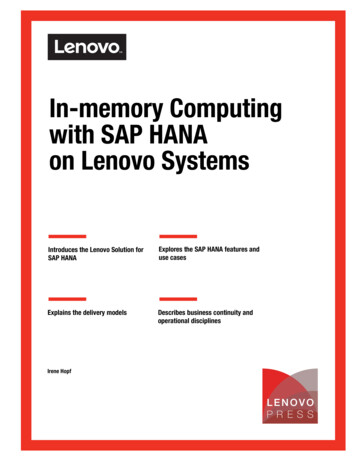
Transcription
Front coverIn-memory Computingwith SAP HANAon Lenovo SystemsIntroduces the Lenovo Solution forSAP HANAExplores the SAP HANA features anduse casesExplains the delivery modelsDescribes business continuity andoperational disciplinesIrene HopfClick here to check for updates
SAP HANA on Lenovo SystemsAugust 2019SG24-8086-05
Note: Before using this information and the product it supports, read the information in “Notices” onpage vii.Last update on August 2019This edition applies to Lenovo ThinkSystem and Lenovo storage and networking offerings. Copyright Lenovo 2019. All rights reserved.Note to U.S. Government Users Restricted Rights -- Use, duplication or disclosure restricted by GSA ADP ScheduleContract
ContentsNotices . . . . . . . . . . . . . . . . . . . . . . . . . . . . . . . . . . . . . . . . . . . . . . . . . . . . . . . . . . . . . . . . . viiTrademarks . . . . . . . . . . . . . . . . . . . . . . . . . . . . . . . . . . . . . . . . . . . . . . . . . . . . . . . . . . . . . viiiPreface . . . . . . . . . . . . . . . . . . . . . . . . . . . . . . . . . . . . . . . . . . . . . . . . . . . . . . . . . . . . . . . . . ixAuthor. . . . . . . . . . . . . . . . . . . . . . . . . . . . . . . . . . . . . . . . . . . . . . . . . . . . . . . . . . . . . . . . . . . .xChapter 1. Basic concepts of in-memory computing . . . . . . . . . . . . . . . . . . . . . . . . . . . 11.1 Keeping data in-memory . . . . . . . . . . . . . . . . . . . . . . . . . . . . . . . . . . . . . . . . . . . . . . . . . 21.1.1 Using main memory as the data store . . . . . . . . . . . . . . . . . . . . . . . . . . . . . . . . . . 21.1.2 Data persistence . . . . . . . . . . . . . . . . . . . . . . . . . . . . . . . . . . . . . . . . . . . . . . . . . . . 31.2 Minimizing data movement . . . . . . . . . . . . . . . . . . . . . . . . . . . . . . . . . . . . . . . . . . . . . . . 31.2.1 Compression . . . . . . . . . . . . . . . . . . . . . . . . . . . . . . . . . . . . . . . . . . . . . . . . . . . . . . 41.2.2 Columnar storage . . . . . . . . . . . . . . . . . . . . . . . . . . . . . . . . . . . . . . . . . . . . . . . . . . 51.2.3 Pushing application logic to the database. . . . . . . . . . . . . . . . . . . . . . . . . . . . . . . . 81.3 Divide and conquer . . . . . . . . . . . . . . . . . . . . . . . . . . . . . . . . . . . . . . . . . . . . . . . . . . . . . 81.3.1 Parallelization on multi-core systems . . . . . . . . . . . . . . . . . . . . . . . . . . . . . . . . . . . 81.3.2 Data partitioning and scale-out . . . . . . . . . . . . . . . . . . . . . . . . . . . . . . . . . . . . . . . . 81.4 Principles for persistent memory . . . . . . . . . . . . . . . . . . . . . . . . . . . . . . . . . . . . . . . . . . . 91.4.1 Architecture . . . . . . . . . . . . . . . . . . . . . . . . . . . . . . . . . . . . . . . . . . . . . . . . . . . . . . 101.4.2 Memory capacity . . . . . . . . . . . . . . . . . . . . . . . . . . . . . . . . . . . . . . . . . . . . . . . . . . 111.4.3 Ratio of DRAM to PMEM . . . . . . . . . . . . . . . . . . . . . . . . . . . . . . . . . . . . . . . . . . . 13Chapter 2. SAP HANA and SAP S/4HANA overview . . . . . . . . . . . . . . . . . . . . . . . . . . .2.1 SAP HANA overview . . . . . . . . . . . . . . . . . . . . . . . . . . . . . . . . . . . . . . . . . . . . . . . . . . .2.1.1 SAP HANA architecture . . . . . . . . . . . . . . . . . . . . . . . . . . . . . . . . . . . . . . . . . . . .2.1.2 SAP HANA system . . . . . . . . . . . . . . . . . . . . . . . . . . . . . . . . . . . . . . . . . . . . . . . .2.2 SAP S/4HANA overview . . . . . . . . . . . . . . . . . . . . . . . . . . . . . . . . . . . . . . . . . . . . . . . .2.3 SAP HANA and SAP S/4HANA delivery models . . . . . . . . . . . . . . . . . . . . . . . . . . . . .2.3.1 SAP HANA as an “appliance” . . . . . . . . . . . . . . . . . . . . . . . . . . . . . . . . . . . . . . . .2.3.2 SAP HANA Tailored Data Center Integration . . . . . . . . . . . . . . . . . . . . . . . . . . . .2.3.3 SAP HANA in the cloud . . . . . . . . . . . . . . . . . . . . . . . . . . . . . . . . . . . . . . . . . . . .2.4 Identifying the right Lenovo solution for SAP HANA . . . . . . . . . . . . . . . . . . . . . . . . . . .2.4.1 Sizing process. . . . . . . . . . . . . . . . . . . . . . . . . . . . . . . . . . . . . . . . . . . . . . . . . . . .1516161718192122232424Chapter 3. Software components and data replication methods . . . . . . . . . . . . . . . . .3.1 SAP HANA software components . . . . . . . . . . . . . . . . . . . . . . . . . . . . . . . . . . . . . . . . .3.1.1 SAP HANA database . . . . . . . . . . . . . . . . . . . . . . . . . . . . . . . . . . . . . . . . . . . . . .3.1.2 SAP HANA client . . . . . . . . . . . . . . . . . . . . . . . . . . . . . . . . . . . . . . . . . . . . . . . . .3.1.3 SAP HANA landscape management structure . . . . . . . . . . . . . . . . . . . . . . . . . . .3.1.4 SAP host agent . . . . . . . . . . . . . . . . . . . . . . . . . . . . . . . . . . . . . . . . . . . . . . . . . . .3.1.5 Solution Manager Diagnostics agent . . . . . . . . . . . . . . . . . . . . . . . . . . . . . . . . . .3.2 Data replication methods for SAP HANA . . . . . . . . . . . . . . . . . . . . . . . . . . . . . . . . . . .3.2.1 Trigger-based replication with SAP Landscape Transformation . . . . . . . . . . . . . .3.2.2 Smart Data Integration and Smart Data Quality . . . . . . . . . . . . . . . . . . . . . . . . . .3.2.3 ETL-based replication with SAP BusinessObjects Data Services . . . . . . . . . . . .3.2.4 SAP HANA Smart Data Access . . . . . . . . . . . . . . . . . . . . . . . . . . . . . . . . . . . . . .3.2.5 Extractor-based replication with Direct Extractor Connection . . . . . . . . . . . . . . . .3.2.6 Log-based replication with SAP Replication Server . . . . . . . . . . . . . . . . . . . . . . .3.2.7 Comparing the replication methods . . . . . . . . . . . . . . . . . . . . . . . . . . . . . . . . . . .313232333434343536363737373839 Copyright Lenovo 2019. All rights reserved.iii
Chapter 4. SAP HANA integration scenarios . . . . . . . . . . . . . . . . . . . . . . . . . . . . . . . . .4.1 Basic use case scenarios . . . . . . . . . . . . . . . . . . . . . . . . . . . . . . . . . . . . . . . . . . . . . . .4.2 SAP HANA as a technology platform . . . . . . . . . . . . . . . . . . . . . . . . . . . . . . . . . . . . . .4.2.1 SAP HANA data acquisition . . . . . . . . . . . . . . . . . . . . . . . . . . . . . . . . . . . . . . . . .4.2.2 SAP HANA as a source for other applications . . . . . . . . . . . . . . . . . . . . . . . . . . .4.3 SAP HANA for operational reporting . . . . . . . . . . . . . . . . . . . . . . . . . . . . . . . . . . . . . . .4.4 SAP HANA as an accelerator . . . . . . . . . . . . . . . . . . . . . . . . . . . . . . . . . . . . . . . . . . . .4.5 SAP products that are running on SAP HANA . . . . . . . . . . . . . . . . . . . . . . . . . . . . . . .4.5.1 SAP Business Warehouse on SAP HANA . . . . . . . . . . . . . . . . . . . . . . . . . . . . . .4.5.2 SAP BW/4HANA . . . . . . . . . . . . . . . . . . . . . . . . . . . . . . . . . . . . . . . . . . . . . . . . . .4.5.3 SAP Business Suite on SAP HANA . . . . . . . . . . . . . . . . . . . . . . . . . . . . . . . . . . .4.5.4 SAP S/4HANA . . . . . . . . . . . . . . . . . . . . . . . . . . . . . . . . . . . . . . . . . . . . . . . . . . .4.6 Programming techniques that use SAP HANA . . . . . . . . . . . . . . . . . . . . . . . . . . . . . . .41424243454649505155565758Chapter 5. Components of the Lenovo Solution for SAP HANA . . . . . . . . . . . . . . . . .5.1 Lenovo ThinkSystem Servers . . . . . . . . . . . . . . . . . . . . . . . . . . . . . . . . . . . . . . . . . . . .5.1.1 Compute trays. . . . . . . . . . . . . . . . . . . . . . . . . . . . . . . . . . . . . . . . . . . . . . . . . . . .5.1.2 Storage tray . . . . . . . . . . . . . . . . . . . . . . . . . . . . . . . . . . . . . . . . . . . . . . . . . . . . .5.1.3 I/O tray . . . . . . . . . . . . . . . . . . . . . . . . . . . . . . . . . . . . . . . . . . . . . . . . . . . . . . . . .5.1.4 Intel Xeon Scalable Processor (SP) family . . . . . . . . . . . . . . . . . . . . . . . . . . . . . .5.1.5 Gold and Platinum product family . . . . . . . . . . . . . . . . . . . . . . . . . . . . . . . . . . . . .5.1.6 Memory subsystem on SR950 . . . . . . . . . . . . . . . . . . . . . . . . . . . . . . . . . . . . . . .5.1.7 Intel Optane DC Persistent Memory . . . . . . . . . . . . . . . . . . . . . . . . . . . . . . . . . . .5.1.8 Storage subsystem . . . . . . . . . . . . . . . . . . . . . . . . . . . . . . . . . . . . . . . . . . . . . . . .5.1.9 Lenovo ThinkSystem SR850 . . . . . . . . . . . . . . . . . . . . . . . . . . . . . . . . . . . . . . . .5.1.10 Lenovo ThinkSystem SR650 . . . . . . . . . . . . . . . . . . . . . . . . . . . . . . . . . . . . . . .5.1.11 XClarity Controller (XCC) . . . . . . . . . . . . . . . . . . . . . . . . . . . . . . . . . . . . . . . . . .5.2 Storage subsystem . . . . . . . . . . . . . . . . . . . . . . . . . . . . . . . . . . . . . . . . . . . . . . . . . . . .5.2.1 Lenovo Storage D1224 Drive Enclosure for SAP HANA . . . . . . . . . . . . . . . . . . .5.2.2 XFS technology. . . . . . . . . . . . . . . . . . . . . . . . . . . . . . . . . . . . . . . . . . . . . . . . . . .5.2.3 Lenovo ThinkSystem DM and DE series storage arrays . . . . . . . . . . . . . . . . . . .5.2.4 Software-defined storage using SUSE Enterprise Storage. . . . . . . . . . . . . . . . . .5.2.5 IBM Spectrum Scale technology . . . . . . . . . . . . . . . . . . . . . . . . . . . . . . . . . . . . . .5.2.6 Single node SAP HANA using XFS . . . . . . . . . . . . . . . . . . . . . . . . . . . . . . . . . . .5.2.7 Scaling out SAP HANA using Spectrum Scale . . . . . . . . . . . . . . . . . . . . . . . . . . .5.3 Networking options . . . . . . . . . . . . . . . . . . . . . . . . . . . . . . . . . . . . . . . . . . . . . . . . . . . .5.4 Workload Optimized Solution for SAP HANA . . . . . . . . . . . . . . . . . . . . . . . . . . . . . . . pter 6. SAP HANA IT landscapes with Lenovo solutions . . . . . . . . . . . . . . . . . . . . 996.1 Lenovo SR950 (Gen 1) . . . . . . . . . . . . . . . . . . . . . . . . . . . . . . . . . . . . . . . . . . . . . . . 1006.1.1 Single-node SR950 solution for analytical and transactional use cases. . . . . . . 1016.1.2 Scale-out SR950 solution for analytical use cases . . . . . . . . . . . . . . . . . . . . . . . 1046.1.3 Scale-out SR950 solution for SAP S/4HANA . . . . . . . . . . . . . . . . . . . . . . . . . . . 1056.2 Lenovo SR650 (Gen1) . . . . . . . . . . . . . . . . . . . . . . . . . . . . . . . . . . . . . . . . . . . . . . . . 1066.3 Lenovo SR 950 (Gen 2) all-flash models . . . . . . . . . . . . . . . . . . . . . . . . . . . . . . . . . . 1076.4 Lenovo SR 950 (Gen 2) and Optane DC Persistent Memory . . . . . . . . . . . . . . . . . . . 1106.5 SAP HANA models using SAN storage . . . . . . . . . . . . . . . . . . . . . . . . . . . . . . . . . . . 1146.6 SAP HANA models using NVMe storage . . . . . . . . . . . . . . . . . . . . . . . . . . . . . . . . . . 1156.7 Consolidation of SAP HANA instances . . . . . . . . . . . . . . . . . . . . . . . . . . . . . . . . . . . . 1166.7.1 Multitenancy built into SAP HANA (MDC). . . . . . . . . . . . . . . . . . . . . . . . . . . . . . 1166.7.2 Consolidation options of SAP HANA. . . . . . . . . . . . . . . . . . . . . . . . . . . . . . . . . . 1176.7.3 SAP HANA on VMware vSphere . . . . . . . . . . . . . . . . . . . . . . . . . . . . . . . . . . . . 1196.7.4 SAP HANA on hyperconverged infrastructure solutions . . . . . . . . . . . . . . . . . . . 1196.8 Security and encryption of an SAP HANA system . . . . . . . . . . . . . . . . . . . . . . . . . . . 120ivSAP HANA on Lenovo Systems
6.8.1 Encrypting SAP HANA data . . . . . . . . . . . . . . . . . . . . . . . . . . . . . . . . . . . . . . . . 1206.8.2 Securing SAP HANA communication channels . . . . . . . . . . . . . . . . . . . . . . . . . 1236.8.3 Securing SAP HANA access. . . . . . . . . . . . . . . . . . . . . . . . . . . . . . . . . . . . . . . . 124Chapter 7. Business continuity and resiliency for SAP HANA . . . . . . . . . . . . . . . . . . 1257.1 Overview of business continuity options . . . . . . . . . . . . . . . . . . . . . . . . . . . . . . . . . . . 1267.1.1 Spectrum Scale based storage replication . . . . . . . . . . . . . . . . . . . . . . . . . . . . . 1287.1.2 SAP HANA System Replication . . . . . . . . . . . . . . . . . . . . . . . . . . . . . . . . . . . . . 1297.1.3 Special considerations for DR and long-distance HA setups . . . . . . . . . . . . . . . 1337.2 HA and DR for single-node SAP HANA . . . . . . . . . . . . . . . . . . . . . . . . . . . . . . . . . . . 1337.3 HA and DR for scale-out SAP HANA . . . . . . . . . . . . . . . . . . . . . . . . . . . . . . . . . . . . . 1367.3.1 HA by using Spectrum Scale storage replication . . . . . . . . . . . . . . . . . . . . . . . . 1377.3.2 HA by using Spectrum Scale replication plus DR by using SAP HANA Replication.1377.4 Backup and restore . . . . . . . . . . . . . . . . . . . . . . . . . . . . . . . . . . . . . . . . . . . . . . . . . . . 1397.4.1 Basic operating system backup and recovery. . . . . . . . . . . . . . . . . . . . . . . . . . . 1397.4.2 Basic database backup and recovery . . . . . . . . . . . . . . . . . . . . . . . . . . . . . . . . . 1397.4.3 File-based backup tool integration . . . . . . . . . . . . . . . . . . . . . . . . . . . . . . . . . . . 1417.4.4 Database backups by using storage snapshots . . . . . . . . . . . . . . . . . . . . . . . . . 1417.4.5 Database backups by using Spectrum Scale snapshots . . . . . . . . . . . . . . . . . . 1437.4.6 Backup tool integration with Backint for SAP HANA . . . . . . . . . . . . . . . . . . . . . . 1437.4.7 Backup and restore as a DR strategy . . . . . . . . . . . . . . . . . . . . . . . . . . . . . . . . . 145Chapter 8. SAP HANA operations . . . . . . . . . . . . . . . . . . . . . . . . . . . . . . . . . . . . . . . . .8.1 Installation services . . . . . . . . . . . . . . . . . . . . . . . . . . . . . . . . . . . . . . . . . . . . . . . . . . .8.2 Lenovo SAP HANA Operations Guide . . . . . . . . . . . . . . . . . . . . . . . . . . . . . . . . . . . .8.3 Interoperability with other platforms . . . . . . . . . . . . . . . . . . . . . . . . . . . . . . . . . . . . . .8.4 Monitoring SAP HANA . . . . . . . . . . . . . . . . . . . . . . . . . . . . . . . . . . . . . . . . . . . . . . . .8.5 Installing more agents . . . . . . . . . . . . . . . . . . . . . . . . . . . . . . . . . . . . . . . . . . . . . . . . .8.6 Software and firmware levels . . . . . . . . . . . . . . . . . . . . . . . . . . . . . . . . . . . . . . . . . . .8.7 Lenovo and SAP Integrated support process . . . . . . . . . . . . . . . . . . . . . . . . . . . . . . .147148148149149150150151Appendix A. Additional topics . . . . . . . . . . . . . . . . . . . . . . . . . . . . . . . . . . . . . . . . . . . .A.1 Supporting Lenovo organizations . . . . . . . . . . . . . . . . . . . . . . . . . . . . . . . . . . . . . . . .A.1.1 Lenovo SAP Center of Competence . . . . . . . . . . . . . . . . . . . . . . . . . . . . . . . . .A.1.2 Lenovo Executive Briefing Center and Innovation Center . . . . . . . . . . . . . . . . .153154154154Related publications . . . . . . . . . . . . . . . . . . . . . . . . . . . . . . . . . . . . . . . . . . . . . . . . . . . .Lenovo Press publications . . . . . . . . . . . . . . . . . . . . . . . . . . . . . . . . . . . . . . . . . . . . . . . . .Online resources . . . . . . . . . . . . . . . . . . . . . . . . . . . . . . . . . . . . . . . . . . . . . . . . . . . . . . . .Help from Lenovo . . . . . . . . . . . . . . . . . . . . . . . . . . . . . . . . . . . . . . . . . . . . . . . . . . . . . . . .155155155155Contentsv
viSAP HANA on Lenovo Systems
NoticesLenovo may not offer the products, services, or features discussed in this document in all countries. Consultyour local Lenovo representative for information on the products and services currently available in yourarea.Any reference to a Lenovo product, program, or service is not intended to state or imply that only that Lenovoproduct, program, or service may be used. Any functionally equivalent product, program, or service that doesnot infringe any Lenovo intellectual property right may be used instead. However, it is the user's responsibilityto evaluate and verify the operation of any other product, program, or service.Lenovo may have patents or pending patent applications covering subject matter described in this document.The furnishing of this document does not give you any license to these patents. You can send licenseinquiries, in writing, to:Lenovo (United States), Inc.1009 Think Place - Building OneMorrisville, NC 27560U.S.A.Attention: Lenovo Director of LicensingLENOVO PROVIDES THIS PUBLICATION “AS IS” WITHOUT WARRANTY OF ANY KIND, EITHEREXPRESS OR IMPLIED, INCLUDING, BUT NOT LIMITED TO, THE IMPLIED WARRANTIES OFNON-INFRINGEMENT, MERCHANTABILITY OR FITNESS FOR A PARTICULAR PURPOSE. Somejurisdictions do not allow disclaimer of express or implied warranties in certain transactions, therefore, thisstatement may not apply to you.This information could include technical inaccuracies or typographical errors. Changes are periodically madeto the information herein; these changes will be incorporated in new editions of the publication. Lenovo maymake improvements and/or changes in the product(s) and/or the program(s) described in this publication atany time without notice.The products described in this document are not intended for use in implantation or other life supportapplications where malfunction may result in injury or death to persons. The information contained in thisdocument does not affect or change Lenovo product specifications or warranties. Nothing in this documentshall operate as an express or implied license or indemnity under the intellectual property rights of Lenovo orthird parties. All information contained in this document was obtained in specific environments and ispresented as an illustration. The result obtained in other operating environments may vary.Lenovo may use or distribute any of the information you supply in any way it believes appropriate withoutincurring any obligation to you.Any references in this publication to non-Lenovo Web sites are provided for convenience only and do not inany manner serve as an endorsement of those Web sites. The materials at those Web sites are not part of thematerials for this Lenovo product, and use of those Web sites is at your own risk.Any performance data contained herein was determined in a controlled environment. Therefore, the resultobtained in other operating environments may vary significantly. Some measurements may have been madeon development-level systems and there is no guarantee that these measurements will be the same ongenerally available systems. Furthermore, some measurements may have been estimated throughextrapolation. Actual results may vary. Users of this document should verify the applicable data for theirspecific environment. Copyright Lenovo 2019. All rights reserved.vii
TrademarksLenovo, the Lenovo logo, and For Those Who Do are trademarks or registered trademarks of Lenovo in theUnited States, other countries, or both. These and other Lenovo trademarked terms are marked on their firstoccurrence in this information with the appropriate symbol ( or ), indicating US registered or common lawtrademarks owned by Lenovo at the time this information was published. Such trademarks may also beregistered or common law trademarks in other countries. A current list of Lenovo trademarks is available onthe Web at http://www.lenovo.com/legal/copytrade.html.The following terms are trademarks of Lenovo in the United States, other countries, or both:AnyBay Lenovo Lenovo XClarity RackSwitch Lenovo(logo) ServeRAID System x ThinkAgile ThinkSystem TruDDR4 The following terms are trademarks of other companies:Intel, Intel Optane, Xeon, and the Intel logo are trademarks or registered trademarks of Intel Corporation or itssubsidiaries in the United States and other countries.Linux is a trademark of Linus Torvalds in the United States, other countries, or both.ActiveX, Azure, Excel, Microsoft, Windows, Windows Server, and the Windows logo are trademarks ofMicrosoft Corporation in the United States, other countries, or both.SAP, SAP HANA, SAP S/4HANA, SAP BW/4HANA, SAP NetWeaver, and other SAP products and servicesare trademarks or registered trademarks of SAP SE or an SAP affiliate company in Germany and othercountries.Other company, product, or service names may be trademarks or service marks of others.viiiSAP HANA on Lenovo Systems
PrefaceThe sixth edition of this LenovoTM Press publication describes in-memory computing systemsfrom Lenovo and SAP that are based on Lenovo systems and SAP HANA. It covers thebasic principles of in-memory computing, describes the Lenovo hardware offerings, andexplains the corresponding SAP HANA IT landscapes that use these offerings.The focus of this new edition is the introduction of persistent memory in Intel Xeon SP Gen 2systems to be used by SAP HANA based applications. Also the change of a more openplatform to design specific configurations according to the customers workload requirements.This book also describes the architecture and components of the Lenovo systems solution forSAP HANA. The following SAP HANA operational disciplines are explained: Scalabilityoptions; high availability and disaster recovery; backup and restore; and virtualizationpossibilities for SAP HANA systems.The following topics also are covered: Basic principles of in-memory computing SAP HANA overview Software components and replication methods SAP HANA use cases and integration scenarios The Lenovo solution for SAP HANA SAP IT landscapes that use the System solution for SAP HANA Options for business continuity (high availability, disaster recovery, and backupand restore) SAP HANA operationsThis book is intended for SAP administrators and technical solution architects. It is also forLenovo Business Partners and Lenovo employees who want to know more about the SAPHANA offering and other available Lenovo solutions for SAP clients.Note: This book has not yet been edited for grammar and readability. Please excuse anyerrors you might find! Copyright Lenovo 2019. All rights reserved.ix
AuthorIrene Hopf leads the Center of Competence for SAP Solutions atLenovo globally. She has more than 25 years of experience in theSAP customer space with infrastructure solutions.In this context she is recognized as a thought leader and givestrusted advise for large scale customer implementations for theintegration of services, hardware and software supporting SAPimplementations.She has written many publications for the SAP ecosystem.Irene has graduated in material science engineering andinformation technology and is based in Walldorf, Germany.Thanks to the authors of the previous edition of this book: Martin Bachmaier Ilya KrutovThanks to the following people for their contributions to this project:From Lenovo: Gereon VeyVijayakumar KulageriTag RobertsonDavid WattsFrom SAP: Dr. Richard Bremer Dr. Thomas BeckerNote: Thank you to our SAP colleagues for their input and contribution to this book. Theirinsights and perspectives help provide deeper insights into the SAP HANA databasetechnology. Please note that the sources of information referenced in this book can befound on www.sap.com and help.sap.com.xSAP HANA on Lenovo Systems
1Chapter 1.Basic concepts of in-memorycomputingIn-memory computing is a technology that allows the processing of massive quantities of datain main memory to provide extremely fast results from analysis and transactions. The datathat is processed is ideally real-time data (that is, data that is available for processing oranalysis immediately after it is created).To achieve the preferred performance, in-memory computing adheres to the following basicconcepts: Keep data in main memory to speed up data access Minimize data movement by using the columnar storage concept, compression, andperforming calculations at the database level Divide and conquer. Use the multicore architecture of modern processors andmultiprocessor servers (or even scale-out into a distributed landscape) to grow beyondwhat can be supplied by a single server.This chapter describes these basic concepts and provides some examples. It does notdescribe the full set of technologies that are used with in-memory databases, such as SAPHANA, but it does provide an overview of how in-memory computing is different fromtraditional concepts.In the sixth edition of this book, this chapter got enhanced with the usage of persistentmemory in SAP HANA, the principle and benefitsThis chapter includes the following topics: 1.1, “Keeping data in-memory” on page 21.2, “Minimizing data movement” on page 31.3, “Divide and conquer” on page 81.4, “Principles for persistent memory” on page 9 Copyright Lenovo 2019. All rights reserved.1
1.1 Keeping data in-memoryToday, a single enterprise class server can hold several terabytes of main memory. At thesame time, prices for server main memory dramatically dropped over the last few decades.This increase in capacity and reduction in cost makes it a viable approach to keep hugeamounts of business data in memory. This section describes the benefits and challenges.1.1.1 Using main memory as the data storeThe most obvious reason to use main memory (RAM) as the data store for a database is thataccessing data in main memory is much faster than accessing data on disk. The comparedaccess times for data in several levels are shown in Figure 0,112x0,010,001CPU registerCPU CacheVolatileRAMSSD/FlashHard diskNon-volatileFigure 1-1 Data access times of various storage types relative to RAM (logarithmic scale)The main memory is the fastest storage type that can hold a significant amount of data.Although CPU registers and CPU cache are faster to access, their usage is limited to theactual data processing. Data in main memory can be accessed more than a hundredthousand times faster than data on a spinning hard disk drive (HDD), and even flashtechnology storage is approximately a thousand times slower than main memory. Mainmemory is connected directly to the processors through a high-speed bus, and hard disks areconnected through a chain of buses (QPI, PCIe, and SAN) and controllers (I/O hub, RAIDcontroller or SAN adapter, and storage controller).Compared with keeping data on disk, keeping the data in main memory can improvedatabase performance through the advantage in access time.2SAP HANA on Lenovo Systems
1.1.2 Data persistenceKeeping data in main memory brings up the issue of what happens if there is a loss of power.In database technology, atomicity, consistency, isolation, and durability (ACID) is the followingset of requirements that ensures that database transactions are processed reliably: A transaction must be atomic. If part of a transaction fails, the entire transaction must failand leave the database state unchanged. The consistency of a database must be preserved by the transactions that it performs. Isolation ensures that no transaction interferes with another transaction. Durability means that after a transaction is committed, it remains committed.Although the first three requirements are not affected by the in-memory concept, durability isa requirement that cannot be met by storing data in main memory alone. Main memory isvolatile storage. It loses its content when it is out of electrical power. To make data persistent,it must be on non-volatile storage, such as HDDs, solid-state drives (SSDs), or flash devices.The storage that is used by a database to store data (in this case, main memory) is dividedinto pages. When a transaction changes data, the corresponding pages are marked andwritten to non-volatile storage in regular intervals. In addition, a database log captures allchanges that are made by transactions. Each committed transaction generates a log entrythat is written to non-volatile storage, which ensures that all transactions are permanent.Figure 1-2 shows this setup by using the example of SAP HANA. SAP HANA stores changedpages in savepoints, which are asynchronously written to persistent storage in regularintervals (by default, every 5 minutes). The log is written synchronously. A transaction doesnot return before the corresponding log entry is written to persistent storage to meet thedurability requirement.TimeData savepointto persistentstorageLog writtento persistent storage(committed transactions)Power failureFigure 1-2 Savepoints and logs in SAP HANAAfter a power failure, the database can be restarted much like a disk-based database. Thedatabase pages are restored from the savepoints and then the database logs are applied(rolled forward) to restore the changes that were not captured in the savepoints. This actionensures that the database can be restored in memory to the same state as before the powerfailure. Even faster ways of restarting the applications to improve business continuity aredescribed in chapter 1.4, “Principles for persistent memory” on page 9.1.2 Minimizing data movementThe second key to improving data processing performance is to minimize the movement ofdata that is within the database and between the database and the application. This sectiondescribes measures to achieve this state.Chapter 1. Basic concepts of in-memory computing3
1.2.1 CompressionAlthough today’s memory capacities allow keeping enormous amounts of data in-memory,compressing the data in-memory is still preferable. The goal is to compress data in a way thatdoes not use up the performance that
Front cover In-memory Computing with SAP HANA on Lenovo Systems Introduces the Lenovo Solution for SAP HANA Explores the SAP HANA features and use cases



